Rare Earth Elements Uptake by Synthetic Polymeric and Cellulose-Based Materials: A Review
Abstract
1. Introduction
2. Chemistry of REEs
3. Applications of REEs
4. Sources and Recovery of REEs
4.1. Primary Sources of REEs
4.2. Secondary Sources of REEs
4.3. Recycling and Recovery of REEs
5. Environmental Impact and Health Effects of REEs
6. Factors Affecting REE Uptake
6.1. Sorption and Functional Groups
6.2. Polymeric Material Structure
7. Synthetic Polymeric Materials for REE Uptake
7.1. Commercial Ion Exchange Resins
7.2. Novel Synthetic Polymeric Materials
7.3. Loaded Synthetic Polymeric Materials
8. Cellulosic Materials for RE Capture
8.1. Low-Molecular-Weight-Molecule-Modified Cellulose Materials
8.2. Polymer-Grafted Cellulose Materials
8.3. Loaded Cellulose Materials
9. Conclusions and Perspective
Author Contributions
Funding
Institutional Review Board Statement
Informed Consent Statement
Data Availability Statement
Conflicts of Interest
References
- Rudnick, R.L.; Gao, S. Composition of the Continental Crust. In Treatise on Geochemistry; Elsevier: Amsterdam, The Netherlands, 2014; pp. 1–51. ISBN 9780080983004. [Google Scholar]
- Cotton, S. Lanthanide and Actinide Chemistry: Cotton/Lanthanide and Actinide Chemistry; John Wiley & Sons, Ltd.: Chichester, UK, 2006; ISBN 9780470010082. [Google Scholar]
- Migaszewski, Z.M.; Gałuszka, A. The Characteristics, Occurrence, and Geochemical Behavior of Rare Earth Elements in the Environment: A Review. Crit. Rev. Environ. Sci. Technol. 2015, 45, 429–471. [Google Scholar] [CrossRef]
- Balaram, V. Rare Earth Elements: A Review of Applications, Occurrence, Exploration, Analysis, Recycling, and Environmental Impact. Geosci. Front. 2019, 10, 1285–1303. [Google Scholar] [CrossRef]
- Dushyantha, N.; Batapola, N.; Ilankoon, I.M.S.K.; Rohitha, S.; Premasiri, R.; Abeysinghe, B.; Ratnayake, N.; Dissanayake, K. The Story of Rare Earth Elements (REEs): Occurrences, Global Distribution, Genesis, Geology, Mineralogy and Global Production. Ore Geol. Rev. 2020, 122, 103521. [Google Scholar] [CrossRef]
- Du, X.; Graedel, T.E. Uncovering the End Uses of the Rare Earth Elements. Sci. Total Environ. 2013, 461–462, 781–784. [Google Scholar] [CrossRef]
- Royer-Lavallée, A.; Neculita, C.M.; Coudert, L. Removal and Potential Recovery of Rare Earth Elements from Mine Water. J. Ind. Eng. Chem. 2020, 89, 47–57. [Google Scholar] [CrossRef]
- Costis, S.; Mueller, K.K.; Coudert, L.; Neculita, C.M.; Reynier, N.; Blais, J.-F. Recovery Potential of Rare Earth Elements from Mining and Industrial Residues: A Review and Cases Studies. J. Geochem. Explor. 2021, 221, 106699. [Google Scholar] [CrossRef]
- Vaziri Hassas, B.; Rezaee, M.; Pisupati, S.V. Precipitation of Rare Earth Elements from Acid Mine Drainage by CO2 Mineralization Process. Chem. Eng. J. 2020, 399, 125716. [Google Scholar] [CrossRef]
- Yuksekdag, A.; Kose-Mutlu, B.; Siddiqui, A.F.; Wiesner, M.R.; Koyuncu, I. A Holistic Approach for the Recovery of Rare Earth Elements and Scandium from Secondary Sources under a Circular Economy Framework—A Review. Chemosphere 2022, 293, 133620. [Google Scholar] [CrossRef]
- Fu, W.; Li, X.; Feng, Y.; Feng, M.; Peng, Z.; Yu, H.; Lin, H. Chemical Weathering of S-Type Granite and Formation of Rare Earth Element (REE)-Rich Regolith in South China: Critical Control of Lithology. Chem. Geol. 2019, 520, 33–51. [Google Scholar] [CrossRef]
- Borst, A.M.; Smith, M.P.; Finch, A.A.; Estrade, G.; Villanova-de-Benavent, C.; Nason, P.; Marquis, E.; Horsburgh, N.J.; Goodenough, K.M.; Xu, C.; et al. Adsorption of Rare Earth Elements in Regolith-Hosted Clay Deposits. Nat. Commun. 2020, 11, 4386. [Google Scholar] [CrossRef]
- Jowitt, S.M.; Werner, T.T.; Weng, Z.; Mudd, G.M. Recycling of the Rare Earth Elements. Curr. Opin. Green Sustain. Chem. 2018, 13, 1–7. [Google Scholar] [CrossRef]
- Tian, L.; Chang, H.; Tang, P.; Li, T.; Zhang, X.; Liu, S.; He, Q.; Wang, T.; Yang, J.; Bai, Y.; et al. Rare Earth Elements Occurrence and Economical Recovery Strategy from Shale Gas Wastewater in the Sichuan Basin, China. ACS Sustain. Chem. Eng. 2020, 8, 11914–11920. [Google Scholar] [CrossRef]
- Chen, L.; Wu, Y.; Dong, H.; Meng, M.; Li, C.; Yan, Y.; Chen, J. An Overview on Membrane Strategies for Rare Earths Extraction and Separation. Sep. Purif. Technol. 2018, 197, 70–85. [Google Scholar] [CrossRef]
- Felipe, E.C.B.; Batista, K.A.; Ladeira, A.C.Q. Recovery of Rare Earth Elements from Acid Mine Drainage by Ion Exchange. Environ. Technol. 2021, 42, 2721–2732. [Google Scholar] [CrossRef]
- Kegl, T.; Košak, A.; Lobnik, A.; Novak, Z.; Kralj, A.K.; Ban, I. Adsorption of Rare Earth Metals from Wastewater by Nanomaterials: A Review. J. Hazard. Mater. 2020, 386, 121632. [Google Scholar] [CrossRef]
- Crini, G.; Lichtfouse, E. Advantages and Disadvantages of Techniques Used for Wastewater Treatment. Environ. Chem. Lett. 2019, 17, 145–155. [Google Scholar] [CrossRef]
- Gwenzi, W.; Mangori, L.; Danha, C.; Chaukura, N.; Dunjana, N.; Sanganyado, E. Sources, Behaviour, and Environmental and Human Health Risks of High-Technology Rare Earth Elements as Emerging Contaminants. Sci. Total Environ. 2018, 636, 299–313. [Google Scholar] [CrossRef]
- Rim, K.-T. Effects of Rare Earth Elements on the Environment and Human Health: A Literature Review. Toxicol. Environ. Health Sci. 2016, 8, 189–200. [Google Scholar] [CrossRef]
- Zhao, Y.; Liang, J.; Meng, H.; Yin, Y.; Zhen, H.; Zheng, X.; Shi, H.; Wu, X.; Zu, Y.; Wang, B.; et al. Rare Earth Elements Lanthanum and Praseodymium Adversely Affect Neural and Cardiovascular Development in Zebrafish (Danio Rerio). Environ. Sci. Technol. 2021, 55, 1155–1166. [Google Scholar] [CrossRef]
- Wang, Y.; Wang, G.; Sun, M.; Liang, X.; He, H.; Zhu, J.; Takahashi, Y. Environmental Risk Assessment of the Potential “Chemical Time Bomb” of Ion-Adsorption Type Rare Earth Elements in Urban Areas. Sci. Total Environ. 2022, 822, 153305. [Google Scholar] [CrossRef]
- Sneller, F.E.C.; Kalf, D.F.; Weltje, L.; Van, W.A.P. Maximum Permissible Concentrations and Negligible Concentrations for Rare Earth Elements (REEs). 2000. Available online: http://hdl.handle.net/10029/9551 (accessed on 25 September 2022).
- Asadollahzadeh, M.; Torkaman, R.; Torab-Mostaedi, M. Extraction and Separation of Rare Earth Elements by Adsorption Approaches: Current Status and Future Trends. Sep. Purif. Rev. 2021, 50, 417–444. [Google Scholar] [CrossRef]
- Anastopoulos, I.; Bhatnagar, A.; Lima, E.C. Adsorption of Rare Earth Metals: A Review of Recent Literature. J. Mol. Liq. 2016, 221, 954–962. [Google Scholar] [CrossRef]
- Rychkov, V.; Kirillov, E.; Kirillov, S.; Bunkov, G.; Botalov, M.; Semenishchev, V.; Smyshlyaev, D.; Malyshev, A.; Taukin, A.; Akcil, A. Rare Earth Element Preconcentration from Various Primary and Secondary Sources by Polymeric Ion Exchange Resins. Sep. Purif. Rev. 2022, 51, 468–483. [Google Scholar] [CrossRef]
- Iftekhar, S.; Ramasamy, D.L.; Srivastava, V.; Asif, M.B.; Sillanpää, M. Understanding the Factors Affecting the Adsorption of Lanthanum Using Different Adsorbents: A Critical Review. Chemosphere 2018, 204, 413–430. [Google Scholar] [CrossRef]
- Ehrlich, G.V.; Lisichkin, G.V. Sorption in the chemistry of rare earth elements. Russ. J. Gen. Chem. 2022, 87, 1220–1245. [Google Scholar] [CrossRef]
- Iftekhar, S.; Heidari, G.; Amanat, N.; Zare, E.N.; Asif, M.B.; Hassanpour, M.; Lehto, V.P.; Sillanpaa, M. Porous Materials for the Recovery of Rare Earth Elements, Platinum Group Metals, and Other Valuable Metals: A Review. Environ. Chem. Lett. 2022. [Google Scholar] [CrossRef]
- Hamed, M.M.; Holiel, M.; Ismail, Z.H. Removal of 134Cs and 152+154Eu from Liquid Radioactive Waste Using Dowex HCR-S/S. Radiochim. Acta 2016, 104, 399–413. [Google Scholar] [CrossRef]
- Cao, X.; Wang, Q.; Wang, S.; Man, R. A Novel Polystyrene-Poly(Hydroxamic Acid) Interpenetrating Polymer Network and Its Adsorption towards Rare Earth Ions. J. Rare Earths 2022, 40, 127–134. [Google Scholar] [CrossRef]
- Shinozaki, T.; Ogata, T.; Kakinuma, R.; Narita, H.; Tokoro, C.; Tanaka, M. Preparation of Polymeric Adsorbents Bearing Diglycolamic Acid Ligands for Rare Earth Elements. Ind. Eng. Chem. Res. 2018, 57, 11424–11430. [Google Scholar] [CrossRef]
- Oye Auke, R.; Arrachart, G.; Tavernier, R.; David, G.; Pellet-Rostaing, S. Terephthalaldehyde-Phenolic Resins as a Solid-Phase Extraction System for the Recovery of Rare-Earth Elements. Polymers 2022, 14, 311. [Google Scholar] [CrossRef]
- Yusoff, M.M.; Mostapa, N.R.N.; Sarkar, M.S.; Biswas, T.K.; Rahman, M.L.; Arshad, S.E.; Sarjadi, M.S.; Kulkarni, A.D. Synthesis of Ion Imprinted Polymers for Selective Recognition and Separation of Rare Earth Metals. J. Rare Earths 2017, 35, 177–186. [Google Scholar] [CrossRef]
- Liu, Z.; Liu, Y.; Gong, A. Preparation of Diglycolamide Polymer Modified Silica and Its Application as Adsorbent for Rare Earth Ions. Des. Monomers Polym. 2019, 22, 1–7. [Google Scholar] [CrossRef]
- Akkaya, R. Synthesis and Characterization of a New Low-Cost Composite for the Adsorption of Rare Earth Ions from Aqueous Solutions. Chem. Eng. J. 2012, 200–202, 186–191. [Google Scholar] [CrossRef]
- Borai, E.H.; Hamed, M.G.; El-kamash, A.M.; Siyam, T.; El-Sayed, G.O. Synthesis, Characterization and Application of a Modified Acrylamide–Styrene Sulfonate Resin and a Composite for Sorption of Some Rare Earth Elements. New J. Chem. 2015, 39, 7409–7420. [Google Scholar] [CrossRef]
- Gad, H.M.H.; Hamed, M.M.; Abo Eldahab, H.M.M.; Moustafa, M.E.; El-Reefy, S.A. Radiation-Induced Grafting Copolymerization of Resin onto the Surface of Silica Extracted from Rice Husk Ash for Adsorption of Gadolinium. J. Mol. Liq. 2017, 231, 45–55. [Google Scholar] [CrossRef]
- Bai, B.; Zhang, Z.; Zhao, X. Enhanced Adsorption of Rare Earth Elements by a Poly(Itaconic Acid)/Magnetite Sepiolite Composite. Anal. Lett. 2021, 54, 1881–1899. [Google Scholar] [CrossRef]
- Zhao, Y.; Liang, T.; Miao, P.; Chen, T.; Han, X.; Hu, G.; Gao, J. Green Preparation of Aminated Magnetic PMMA Microspheres via EB Irradiation and Its Highly Efficient Uptake of Ce(III). Materials 2022, 15, 6553. [Google Scholar] [CrossRef]
- Nkinahamira, F.; Alsbaiee, A.; Wang, Y.; Yang, X.; Chen, T.-Y.; Cao, M.; Feng, M.; Sun, Q.; Yu, C.-P. Recovery and Purification of Rare Earth Elements from Wastewater and Sludge Using a Porous Magnetic Composite of β-Cyclodextrin and Silica Doped with PC88A. Sep. Purif. Technol. 2021, 266, 118589. [Google Scholar] [CrossRef]
- Zhu, Y.; Zheng, Y.; Wang, A. Preparation of Granular Hydrogel Composite by the Redox Couple for Efficient and Fast Adsorption of La(III) and Ce(III). J. Environ. Chem. Eng. 2015, 3, 1416–1425. [Google Scholar] [CrossRef]
- Inamuddin, D.; Luqman, M. (Eds.) Ion Exchange Technology I; Springer: Dordrecht, The Netherlands, 2012; ISBN 9789400716995. [Google Scholar]
- Meyer, V.R. Practical High-Performance Liquid Chromatography; Wiley: New York, NY, USA, 2010; ISBN 9780470682180. [Google Scholar]
- Jordens, A.; Cheng, Y.P.; Waters, K.E. A Review of the Beneficiation of Rare Earth Element Bearing Minerals. Miner. Eng. 2013, 41, 97–114. [Google Scholar] [CrossRef]
- Sperling, L.H. Interpenetrating Polymer Networks and Related Materials; Springer US: Boston, MA, USA, 1981; ISBN 9781468438321. [Google Scholar]
- Giraldo, L.F.; López, B.L.; Pérez, L.; Urrego, S.; Sierra, L.; Mesa, M. Mesoporous Silica Applications. Macromol. Symp. 2007, 258, 129–141. [Google Scholar] [CrossRef]
- Keane, D.A.; Hanrahan, J.P.; Copley, M.P.; Holmes, J.D.; Morris, M.A. A Modified Stöber Process for the Production of Mesoporous Sub 2 Micron Silica Microspheres; Applications in HPLC. J. Porous Mater. 2010, 17, 145–152. [Google Scholar] [CrossRef]
- Jeelani, P.G.; Mulay, P.; Venkat, R.; Ramalingam, C. Multifaceted Application of Silica Nanoparticles. A Review. Silicon 2020, 12, 1337–1354. [Google Scholar] [CrossRef]
- Wei, Y.; Han, B.; Hu, X.; Lin, Y.; Wang, X.; Deng, X. Synthesis of Fe3O4 Nanoparticles and Their Magnetic Properties. Procedia Eng. 2012, 27, 632–637. [Google Scholar] [CrossRef]
- Li, X.-M.; Xu, G.; Liu, Y.; He, T. Magnetic Fe3O4 Nanoparticles: Synthesis and Application in Water Treatment. Nanosci. Nanotechnol.-Asia 2012, 1, 14–24. [Google Scholar] [CrossRef]
- Xin, X.; Wei, Q.; Yang, J.; Yan, L.; Feng, R.; Chen, G.; Du, B.; Li, H. Highly Efficient Removal of Heavy Metal Ions by Amine-Functionalized Mesoporous Fe3O4 Nanoparticles. Chem. Eng. J. 2012, 184, 132–140. [Google Scholar] [CrossRef]
- Zhao, J.; Liu, J.; Li, N.; Wang, W.; Nan, J.; Zhao, Z.; Cui, F. Highly Efficient Removal of Bivalent Heavy Metals from Aqueous Systems by Magnetic Porous Fe3O4-MnO2: Adsorption Behavior and Process Study. Chem. Eng. J. 2016, 304, 737–746. [Google Scholar] [CrossRef]
- Liu, S.; Yu, B.; Wang, S.; Shen, Y.; Cong, H. Preparation, Surface Functionalization and Application of Fe3O4 Magnetic Nanoparticles. Adv. Colloid Interface Sci. 2020, 281, 102165. [Google Scholar] [CrossRef]
- Abdul Khalil, H.P.S.; Bhat, A.H.; Ireana Yusra, A.F. Green Composites from Sustainable Cellulose Nanofibrils: A Review. Carbohydr. Polym. 2012, 87, 963–979. [Google Scholar] [CrossRef]
- Wang, D. A Critical Review of Cellulose-Based Nanomaterials for Water Purification in Industrial Processes. Cellulose 2019, 26, 687–701. [Google Scholar] [CrossRef]
- Roy, D.; Semsarilar, M.; Guthrie, J.T.; Perrier, S. Cellulose Modification by Polymer Grafting: A Review. Chem. Soc. Rev. 2009, 38, 2046–2064. [Google Scholar] [CrossRef] [PubMed]
- Nasrollahzadeh, M.; Sajjadi, M.; Iravani, S.; Varma, R.S. Starch, Cellulose, Pectin, Gum, Alginate, Chitin and Chitosan Derived (Nano)Materials for Sustainable Water Treatment: A Review. Carbohydr. Polym. 2021, 251, 116986. [Google Scholar] [CrossRef] [PubMed]
- Liu, P.; Sehaqui, H.; Tingaut, P.; Wichser, A.; Oksman, K.; Mathew, A.P. Cellulose and Chitin Nanomaterials for Capturing Silver Ions (Ag+) from Water via Surface Adsorption. Cellulose 2014, 21, 449–461. [Google Scholar] [CrossRef]
- Liu, P.; Borrell, P.F.; Božič, M.; Kokol, V.; Oksman, K.; Mathew, A.P. Nanocelluloses and Their Phosphorylated Derivatives for Selective Adsorption of Ag(+), Cu(2+) and Fe(3+) from Industrial Effluents. J. Hazard. Mater. 2015, 294, 177–185. [Google Scholar] [CrossRef]
- Yu, X.; Tong, S.; Ge, M.; Wu, L.; Zuo, J.; Cao, C.; Song, W. Adsorption of Heavy Metal Ions from Aqueous Solution by Carboxylated Cellulose Nanocrystals. J. Environ. Sci. 2013, 25, 933–943. [Google Scholar] [CrossRef]
- Singh, K.; Arora, J.K.; Sinha, T.J.M.; Srivastava, S. Functionalization of Nanocrystalline Cellulose for Decontamination of Cr(III) and Cr(VI) from Aqueous System: Computational Modeling Approach. Clean Technol. Environ. Policy 2014, 16, 1179–1191. [Google Scholar] [CrossRef]
- Sehaqui, H.; de Larraya, U.P.; Liu, P.; Pfenninger, N.; Mathew, A.P.; Zimmermann, T.; Tingaut, P. Enhancing Adsorption of Heavy Metal Ions onto Biobased Nanofibers from Waste Pulp Residues for Application in Wastewater Treatment. Cellulose 2014, 21, 2831–2844. [Google Scholar] [CrossRef]
- Dwivedi, A.D.; Dubey, S.P.; Hokkanen, S.; Sillanpää, M. Mechanistic Investigation on the Green Recovery of Ionic, Nanocrystalline, and Metallic Gold by Two Anionic Nanocelluloses. Chem. Eng. J. 2014, 253, 316–324. [Google Scholar] [CrossRef]
- Sheikhi, A.; Safari, S.; Yang, H.; van de Ven, T.G.M. Copper Removal Using Electrosterically Stabilized Nanocrystalline Cellulose. ACS Appl. Mater. Interfaces 2015, 7, 11301–11308. [Google Scholar] [CrossRef]
- Hokkanen, S.; Repo, E.; Westholm, L.J.; Lou, S.; Sainio, T.; Sillanpää, M. Adsorption of Ni2+, Cd2+, PO43− and NO3− from Aqueous Solutions by Nanostructured Microfibrillated Cellulose Modified with Carbonated Hydroxyapatite. Chem. Eng. J. 2014, 252, 64–74. [Google Scholar] [CrossRef]
- Anirudhan, T.S.; Shainy, F. Effective Removal of Mercury(II) Ions from Chlor-Alkali Industrial Wastewater Using 2-Mercaptobenzamide Modified Itaconic Acid-Grafted-Magnetite Nanocellulose Composite. J. Colloid Interface Sci. 2015, 456, 22–31. [Google Scholar] [CrossRef] [PubMed]
- Wang, N.; Ouyang, X.-K.; Yang, L.-Y.; Omer, A.M. Fabrication of a Magnetic Cellulose Nanocrystal/Metal–Organic Framework Composite for Removal of Pb(II) from Water. ACS Sustain. Chem. Eng. 2017, 5, 10447–10458. [Google Scholar] [CrossRef]
- Zhang, N.; Zang, G.-L.; Shi, C.; Yu, H.-Q.; Sheng, G.-P. A Novel Adsorbent TEMPO-Mediated Oxidized Cellulose Nanofibrils Modified with PEI: Preparation, Characterization, and Application for Cu(II) Removal. J. Hazard. Mater. 2016, 316, 11–18. [Google Scholar] [CrossRef] [PubMed]
- Anirudhan, T.S.; Deepa, J.R.; Christa, J. Nanocellulose/Nanobentonite Composite Anchored with Multi-Carboxyl Functional Groups as an Adsorbent for the Effective Removal of Cobalt(II) from Nuclear Industry Wastewater Samples. J. Colloid Interface Sci. 2016, 467, 307–320. [Google Scholar] [CrossRef]
- Zheng, Q.; Cai, Z.; Gong, S. Green Synthesis of Polyvinyl Alcohol (PVA)–Cellulose Nanofibril (CNF) Hybrid Aerogels and Their Use as Superabsorbents. J. Mater. Chem. A 2014, 2, 3110–3118. [Google Scholar] [CrossRef]
- Zhou, Y.; Fu, S.; Zhang, L.; Zhan, H.; Levit, M.V. Use of Carboxylated Cellulose Nanofibrils-Filled Magnetic Chitosan Hydrogel Beads as Adsorbents for Pb(II). Carbohydr. Polym. 2014, 101, 75–82. [Google Scholar] [CrossRef]
- Dai, L.; Cheng, T.; Xi, X.; Nie, S.; Ke, H.; Liu, Y.; Tong, S.; Chen, Z. A Versatile TOCN/CGG Self-Assembling Hydrogel for Integrated Wastewater Treatment. Cellulose 2020, 27, 915–925. [Google Scholar] [CrossRef]
- Zhuang, S.; Wang, J. Removal of Cesium Ions Using Nickel Hexacyanoferrates-Loaded Bacterial Cellulose Membrane as an Effective Adsorbent. J. Mol. Liq. 2019, 294, 111682. [Google Scholar] [CrossRef]
- Hashem, M.A.; Elnagar, M.M.; Kenawy, I.M.; Ismail, M.A. Synthesis and Application of Hydrazono-Imidazoline Modified Cellulose for Selective Separation of Precious Metals from Geological Samples. Carbohydr. Polym. 2020, 237, 116177. [Google Scholar] [CrossRef]
- Neira, J.Y.; Boulett, A.; Roa, K.; Oyarzún, D.P.; Sánchez, J. Vegetable Filters Reinforced with Fibrillated Cellulose for Iron Removal from Water and Organic White Wines. Environ. Technol. Innov. 2022, 25, 102104. [Google Scholar] [CrossRef]
- Sánchez, J.; Butter, B.; Rivas, B.L. Biopolymers Applied to Remove Metal Ions through Ultrafiltration. A Review. J. Chil. Chem. Soc. 2020, 65, 5004–5010. [Google Scholar] [CrossRef]
- Sánchez, J.; Dax, D.; Tapiero, Y.; Xu, C.; Willför, S. Bio-Based Hydrogels with Ion Exchange Properties Applied to Remove Cu(II), Cr(VI), and as(V) Ions from Water. Front. Bioeng. Biotechnol. 2021, 9, 656472. [Google Scholar] [CrossRef] [PubMed]
- Yu, X.; Tong, S.; Ge, M.; Wu, L.; Zuo, J.; Cao, C.; Song, W. Synthesis and Characterization of Multi-Amino-Functionalized Cellulose for Arsenic Adsorption. Carbohydr. Polym. 2013, 92, 380–387. [Google Scholar] [CrossRef]
- Qiu, B.; Xu, C.; Sun, D.; Yi, H.; Guo, J.; Zhang, X.; Qu, H.; Guerrero, M.; Wang, X.; Noel, N.; et al. Polyaniline Coated Ethyl Cellulose with Improved Hexavalent Chromium Removal. ACS Sustain. Chem. Eng. 2014, 2, 2070–2080. [Google Scholar] [CrossRef]
- Hosseinkhani, A.; Forouzesh Rad, B.; Baghdadi, M. Efficient Removal of Hexavalent Chromium from Electroplating Wastewater Using Polypyrrole Coated on Cellulose Sulfate Fibers. J. Environ. Manag. 2020, 274, 111153. [Google Scholar] [CrossRef]
- González-López, M.E.; Laureano-Anzaldo, C.M.; Pérez-Fonseca, A.A.; Arellano, M.; Robledo-Ortíz, J.R. Chemically Modified Polysaccharides for Hexavalent Chromium Adsorption. Sep. Purif. Rev. 2021, 50, 333–362. [Google Scholar] [CrossRef]
- Sánchez, J.; Espinosa, C.; Tapiero, Y.; Santiago-García, J.L.; Oyarzún, D.P.; Pizarro, G.D.C. Modification of Regenerated Cellulose Membranes with Cationic Polymer and Its Cr(VI) Retention Capacity. J. Water Process Eng. 2019, 30, 100619. [Google Scholar] [CrossRef]
- Dax, D.; Honorato, C.; Liu, J.; Xu, C.; Willför, S.; Bastidas, M.S.C.; Sánchez, J.; Spoljaric, S.; Seppälä, J.; Mendonça, R.T. Tailor-Made Hemicellulose-Based Hydrogels Reinforced with Nanofibrillated Cellulose. Nord. Pulp Paper Res. J. 2015, 30, 373–384. [Google Scholar] [CrossRef]
- Sánchez, J.; Butter, B.; Chavez, S.; Riffo, L.; Basáez, L.; Rivas, B.L. Quaternized Hydroxyethyl Cellulose Ethoxylate and Membrane Separation Techniques for Arsenic Removal. Desalination Water Treat. 2016, 57, 25161–25169. [Google Scholar] [CrossRef]
- Gallardo, K.; Castillo, R.; Mancilla, N.; Remonsellez, F. Biosorption of Rare-Earth Elements from Aqueous Solutions Using Walnut Shell. Front. Chem. Eng. 2020, 2, 4. [Google Scholar] [CrossRef]
- Negrea, A.; Gabor, A.; Davidescu, C.M.; Ciopec, M.; Negrea, P.; Duteanu, N.; Barbulescu, A. Rare Earth Elements Removal from Water Using Natural Polymers. Sci. Rep. 2018, 8, 316. [Google Scholar] [CrossRef] [PubMed]
- Alcaraz, L.; Saquinga, D.N.; López, F.; Lima, L.D.; Alguacil, F.J.; Escudero, E.; López, F.A. Application of a Low-Cost Cellulose-Based Bioadsorbent for the Effective Recovery of Terbium Ions from Aqueous Solutions. Metals 2020, 10, 1641. [Google Scholar] [CrossRef]
- Li, C.; Ma, H.; Venkateswaran, S.; Hsiao, B.S. Sustainable Carboxylated Cellulose Filters for Efficient Removal and Recovery of Lanthanum. Environ. Res. 2020, 188, 109685. [Google Scholar] [CrossRef]
- Zhan, C.; Sharma, P.R.; He, H.; Sharma, S.K.; McCauley-Pearl, A.; Wang, R.; Hsiao, B.S. Rice Husk Based Nanocellulose Scaffolds for Highly Efficient Removal of Heavy Metal Ions from Contaminated Water. Environ. Sci. Water Res. Technol. 2020, 6, 3080–3090. [Google Scholar] [CrossRef]
- Wamea, P.; Pitcher, M.L.; Muthami, J.; Sheikhi, A. Nanoengineering Cellulose for the Selective Removal of Neodymium: Towards Sustainable Rare Earth Element Recovery. Chem. Eng. J. 2022, 428, 131086. [Google Scholar] [CrossRef]
- Zhao, F.; Repo, E.; Song, Y.; Yin, D.; Hammouda, S.B.; Chen, L.; Kalliola, S.; Tang, J.; Tam, K.C.; Sillanpää, M. Polyethylenimine-Cross-Linked Cellulose Nanocrystals for Highly Efficient Recovery of Rare Earth Elements from Water and a Mechanism Study. Green Chem. 2017, 19, 4816–4828. [Google Scholar] [CrossRef]
- Rahman, M.L.; Sarjadi, M.S.; Arshad, S.E.; Yusoff, M.M.; Sarkar, S.M.; Musta, B. Kenaf Cellulose-Based Poly(Amidoxime) Ligand for Adsorption of Rare Earth Ions. Rare Met. 2019, 38, 259–269. [Google Scholar] [CrossRef]
- Tolba, A.A.; Mohamady, S.I.; Hussin, S.S.; Akashi, T.; Sakai, Y.; Galhoum, A.A.; Guibal, E. Synthesis and Characterization of Poly(Carboxymethyl)-Cellulose for Enhanced La(III) Sorption. Carbohydr. Polym. 2017, 157, 1809–1820. [Google Scholar] [CrossRef]
- Zheng, X.; Sun, W.; Li, A.; Zhang, Y.; Li, Z. Bacterial Cellulose Nanofibrous Ion Imprinted Aerogel for Highly Efficient Recognition and Adsorption of Dy(III). Process Saf. Environ. Prot. 2022, 160, 70–79. [Google Scholar] [CrossRef]
- Zhang, Y.; Zheng, X.; Bian, T.; Zhang, Y.; Mei, J.; Li, Z. Phosphorylated-CNC/MWCNT Thin Films-toward Efficient Adsorption of Rare Earth La(III). Cellulose 2020, 27, 3379–3390. [Google Scholar] [CrossRef]
- Zheng, X.; Zhang, Y.; Bian, T.; Zhang, Y.; Li, Z.; Pan, J. Oxidized Carbon Materials Cooperative Construct Ionic Imprinted Cellulose Nanocrystals Films for Efficient Adsorption of Dy(III). Chem. Eng. J. 2020, 381, 122669. [Google Scholar] [CrossRef]
- Iftekhar, S.; Srivastava, V.; Sillanpää, M. Enrichment of Lanthanides in Aqueous System by Cellulose Based Silica Nanocomposite. Chem. Eng. J. 2017, 320, 151–159. [Google Scholar] [CrossRef]
- Iftekhar, S.; Srivastava, V.; Sillanpää, M. Synthesis and Application of LDH Intercalated Cellulose Nanocomposite for Separation of Rare Earth Elements (REEs). Chem. Eng. J. 2017, 309, 130–139. [Google Scholar] [CrossRef]
- Rodríguez-Fernández, E.; Manzano, J.L.; Benito, J.J.; Hermosa, R.; Monte, E.; Criado, J.J. Thiourea, Triazole and Thiadiazine Compounds and Their Metal Complexes as Antifungal Agents. J. Inorg. Biochem. 2005, 99, 1558–1572. [Google Scholar] [CrossRef]
- Arslan, H.; Külcü, N.; Flörke, U. Synthesis and characterization of copper(II), nickel(II) and cobalt(II) complexes with novel thiourea derivatives. Transit. Met. Chem. 2003, 28, 816–819. [Google Scholar] [CrossRef]
- Yörükoğlu, A.; Obut, A.; Girgin, İ. Effect of Thiourea on Sulphuric Acid Leaching of Bastnaesite. Hydrometallurgy 2003, 68, 195–202. [Google Scholar] [CrossRef]
- Rahman, M.S.; Hasan, M.S.; Nitai, A.S.; Nam, S.; Karmakar, A.K.; Ahsan, M.S.; Shiddiky, M.J.A.; Ahmed, M.B. Recent Developments of Carboxymethyl Cellulose. Polymers 2021, 13, 1345. [Google Scholar] [CrossRef]
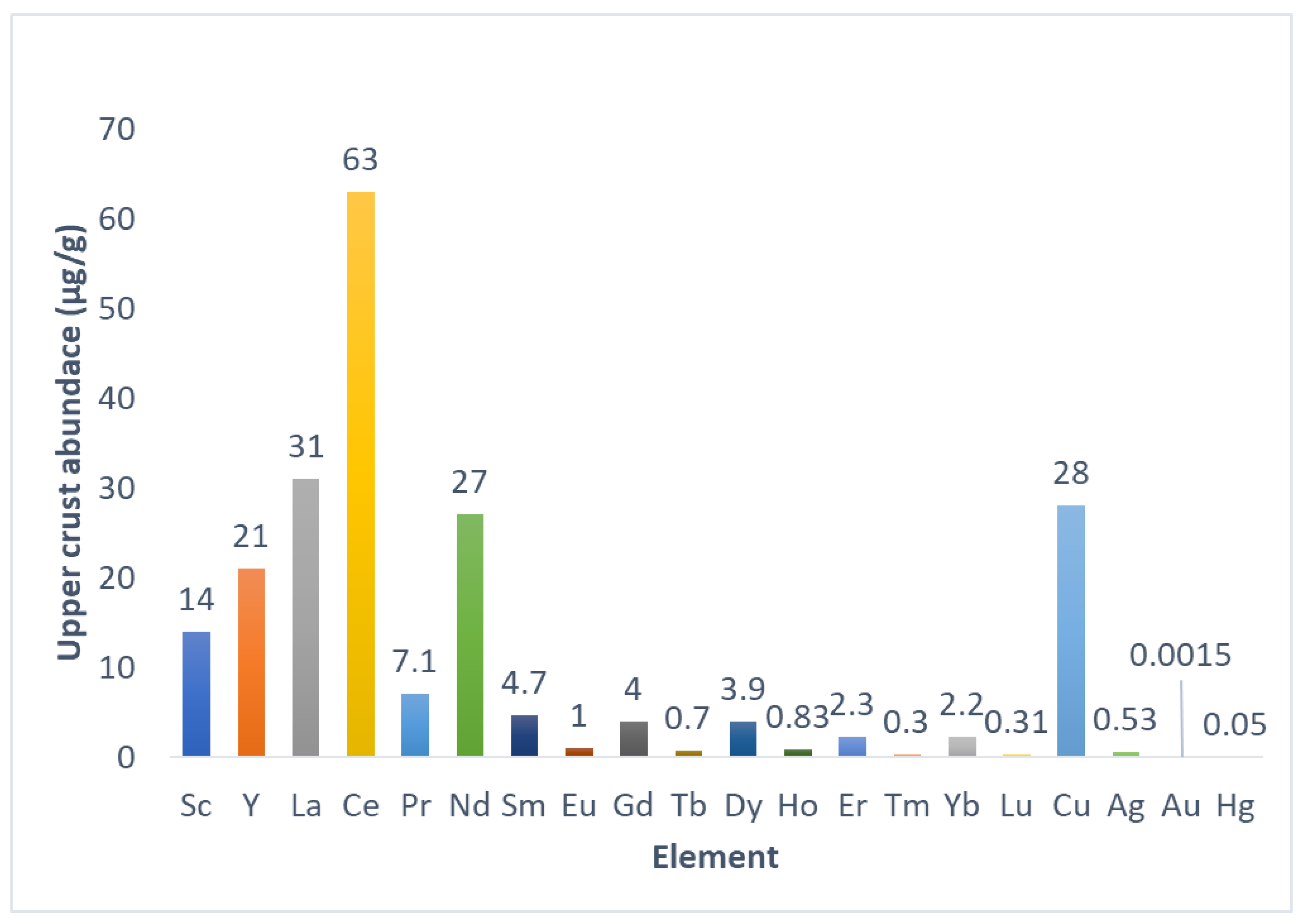
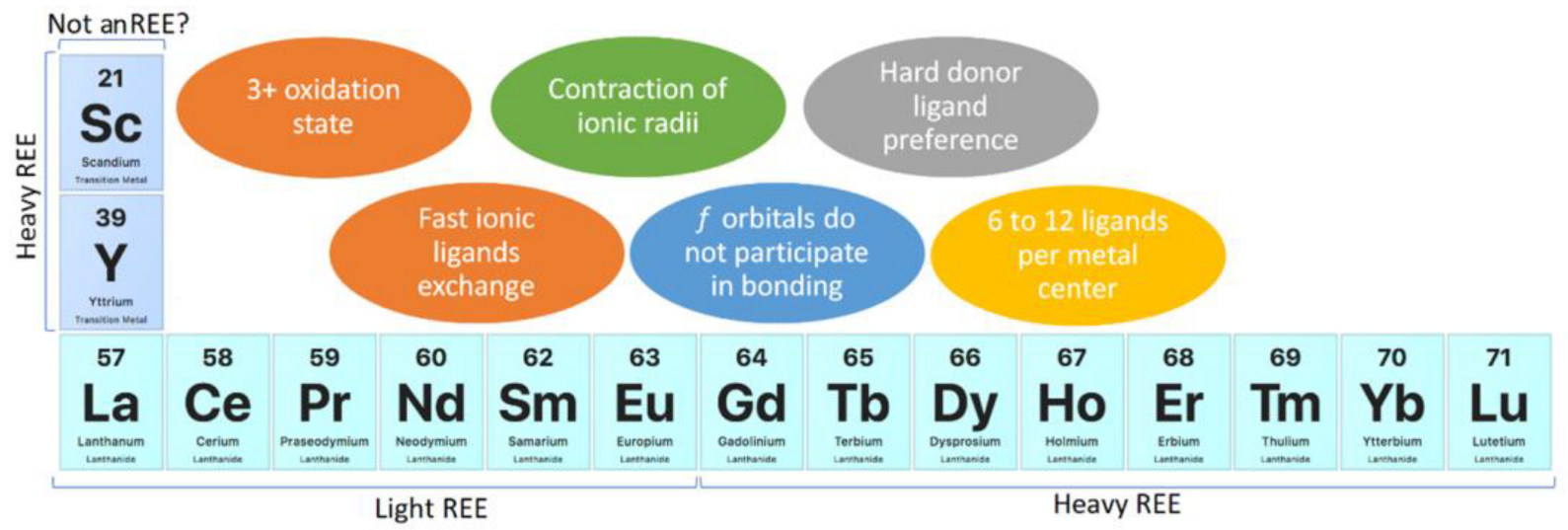
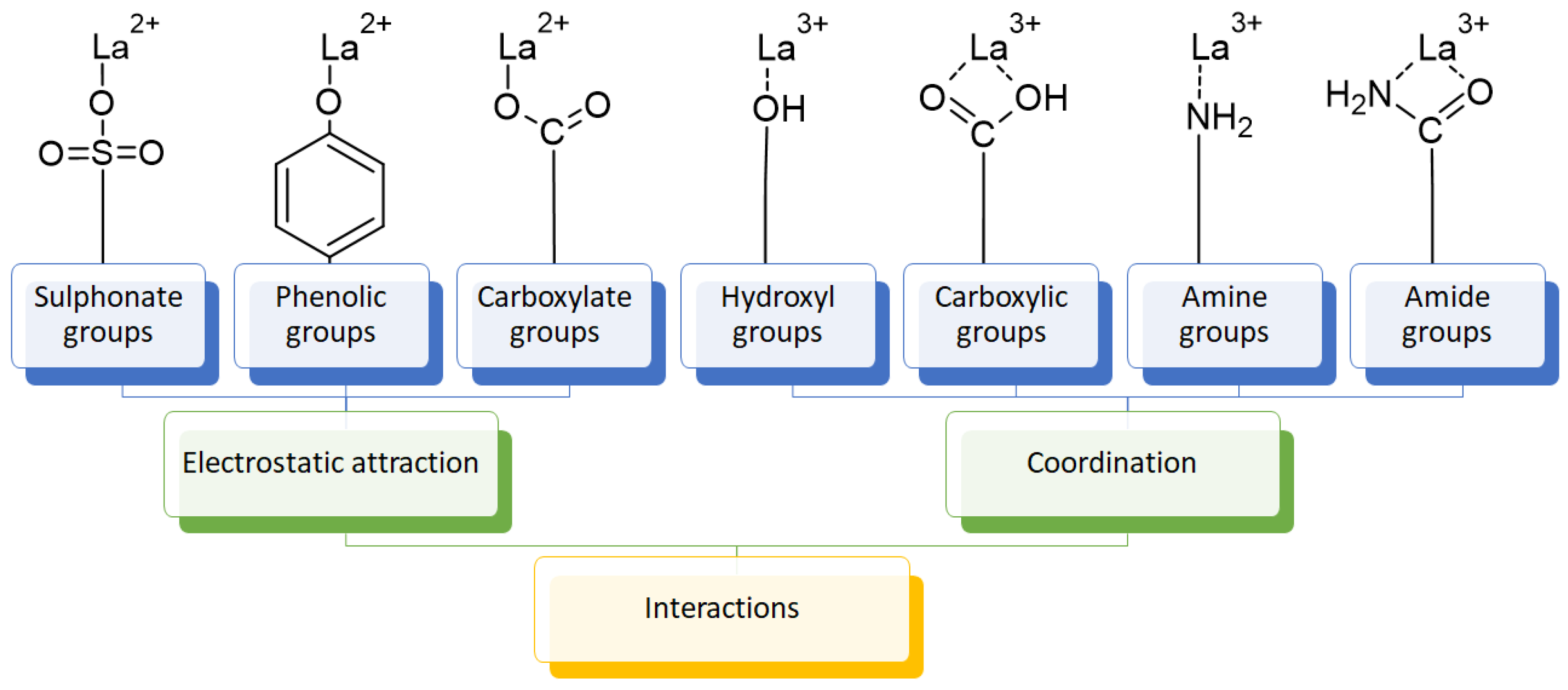
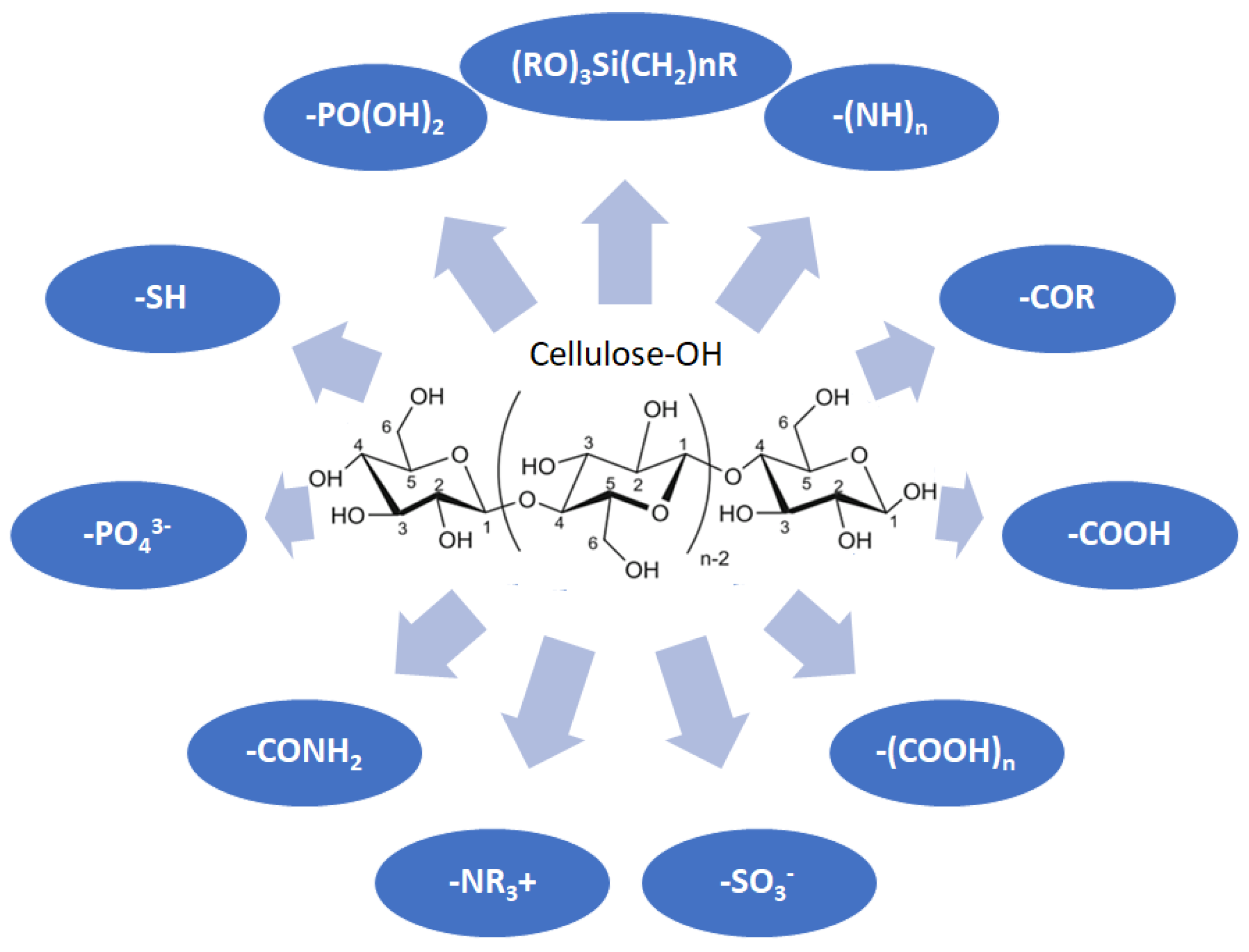
| Application Field | REEs Involved | Uses |
|---|---|---|
| Electronics | La, Eu, Gd | Screen, personal computers, mobile phones, silicon chips, LED diodes, fluorescent lamps |
| Technology | La, Pr, Nd, Sm, Eu, Tb, Dy, Ho, Er, Yb | Lasers, masers, fiber optics, radars, nuclear reactors, lamps, high-reflectance glass, high-temperature superconductors |
| Medical sciences | Y, Eu, Gd, Tm, Lu, Sm | X-ray apparatus, nuclear resonance imaging, cancer treatments |
| Renewable energies | La, Pr, Nd, Eu, Tb | Electric cars, turbines, batteries |
| Chemical and industrial processes | La, Ce, Pr, Nd, Yb, Er, Lu | Catalysts, steel manufacture, magnets, pigments, colorants, oxidizers, plastics, catalytic converters, catalytic columns |
| Agriculture | La, Ce, Pr, Nd | Fertilizers, crop yield and crop quality enhancers |
| Polymeric Material | Functional Groups Involved | Ion Captured | Capacity q (mg/g) | Conditions Temperature (°C, pH) | Ref. |
|---|---|---|---|---|---|
| Dowex 50WX8 |  | Y (III) | 11.2 | 25, 3.4 | [16] |
| La (III) | 25.4 | ||||
| Ce (III) | 23.3 | ||||
| Nd (III) | 21.1 | ||||
| Dy (III) | 16.9 | ||||
| Gd (III) | 17.7 | ||||
| Lewatit MDS 200H |  | Y (III) | 10.6 | 25, 3.4 | [16] |
| La (III) | 26.8 | ||||
| Ce (III) | 24.9 | ||||
| Nd (III) | 20.9 | ||||
| Dy (III) | 16.2 | ||||
| Gd (III) | 17.9 | ||||
| Purolite C160 |  | Y (III) | 10.0 | 25, 3.4 | [16] |
| La (III) | 28.7 | ||||
| Ce (III) | 26.4 | ||||
| Nd (III) | 25.5 | ||||
| Dy (III) | 13.0 | ||||
| Gd (III) | 13.8 | ||||
| Dowex SCX HCR-S/S |  | Eu (III) | 161.9 | 25, 4.5 | [30] |
| Interpenetrating polymer network (IPN) resin polystyrene-poly (hydroxamic acid) |   | La (III) | 150.0 | 25, 4.0 | [31] |
| Ce (III) | 200.3 | ||||
| Y (III) | 120.9 | ||||
| Polystyrene/divinylbenzene/diglycolamic acid | 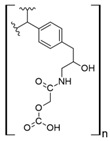 | Dy (III) | 17.8 | 25, 1.0–3.0 | [32] |
| Resorcinol–terephthalaldehyde resin |  | Eu (III) | 70.0 | 25, 4.0 | [33] |
| Poly(4-vinylpyridine)–Schiff base lanthanide ion–imprinted polymer (Ln-IIP) | 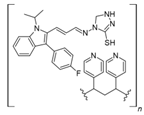 | Pr (III) | 125.3 | 25, 6.0 | [34] |
| Nd (III) | 126.5 | ||||
| Sm (III) | 127.6 | ||||
| Eu (III) | 128.2 | ||||
| Gd (III) | 129.1 | ||||
| Silica-supported poly-diglycolamide |  | La (III) | 29.0 | 25, 2.0–3.0 | [35] |
| Ce (III) | 32.0 | ||||
| Pr (III) | 33.0 | ||||
| Nd (III) | 35,0 | ||||
| Sm (III) | 39.0 | ||||
| Eu (III) | 42.0 | ||||
| Gd (III) | 51.0 | ||||
| Tb (III) | 48.0 | ||||
| Dy (III) | 51.0 | ||||
| Ho (III) | 52.0 | ||||
| Er (III) | 51.0 | ||||
| Tm (III) | 50.0 | ||||
| Yb (III) | 48.0 | ||||
| Lu (III) | 49.0 | ||||
| Polyacrylamide@perlite (70%–75% SiO2) | 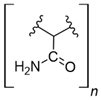 | Tb (III) | 24.2 29.4 | 25, 6.0 | [36] |
| Poly(acrylamide–sodium 4-styrenesulfonate)@SiO2 | 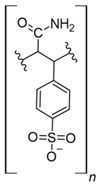 | La (III), | 136.0 | 25, 5.0 | [37] |
| Ce (III) | 132.0 | ||||
| Nd (III) | 124.0 | ||||
| Eu (III) | 108.0 | ||||
| Poly(acrylamide–acrylic acid–sodium 4-styrenesulfonate)@SiO2 | 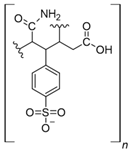 | Gd (III) | 206.6 | 25, 6.0–7.0 | [38] |
| Poly(itaconic acid)@sepiolite Fe3O4 | 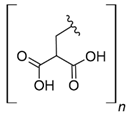 | Ce (III) | 106.3 | 35, 4.0–7.0 | [39] |
| Nd (III) | 151.2 | ||||
| Er (III) | 178.5 | ||||
| 2-ethylhexyl phosphonic acid mono-2-ethylhexyl (PC88A) doped silica functionalized β-cyclodextrin@Fe3O4 |  | Y (III) | 64.2 | 25, 5.0 | [40] |
| Nd (III) | 49.2 | ||||
| Eu (III) | 51.1 | ||||
| Gd (III) | 40.9 | ||||
| Poly(methyl methacrylate–glycidyl methacrylate–ethylenimine)-grafted-Fe3O4 |  | Ce (III) | 189.8 | 45, 6.0 | [41] |
| Chitosan-grafted-poly (acrylic acid)@attapulgite (Mg2Al2)Si8O20(OH)2·4H2O | 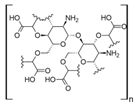 | La (III) | 333.3 | 25, 4.0–7.0 | [42] |
| Ce (III) | 243.9 |
| Cellulosic Material | Functional Groups Involved | Captured Ion | Capacity q (mg/g) | Conditions T° (°C, pH) | Ref |
|---|---|---|---|---|---|
| Nutshell cellulose |  | Eu (III) | 5.7 | 25, 4.0 | [86] |
| Gd (III) | 5.1 | ||||
| Sm (III) | 6.1 | ||||
| La (III) | 6.0 | ||||
| Thiourea functionalized cellulose |  | Nd (III) | 73.0 | 25, - | [87] |
| Eu (III) | 27.0 | ||||
| Carboxylated cellulose |  | Tb (III) | 25.2 | 25, 5.0 | [88] |
| Carboxylated cellulose |  | La (III) | 33.7 | 25, 6.0 | [89] |
| Carboxylated nanofibrillated cellulose (NFC) |  | La (III) | 100.7 | 25, 7.0 | [90] |
| Dicarboxylated cellulose/NCC |  | Nd (III) | 264.0 | 25, 4.0–6.0 | [91] |
| Carboxylated NCC/polyethyleneimine (PEI) s-IPN |  | La (III) | 84.8 | 25, 5.4–6.5 | [92] |
| Eu (III) | 101.7 | ||||
| Er (III) | 120.2 | ||||
| Poly(amidoxime)-grafted-cellulose |  | La (III) | 262.0 | 25, 6.0 | [93] |
| Ce (III) | 255.0 | ||||
| Pr (III) | 244.0 | ||||
| Nd (III) | 241.0 | ||||
| Microcrystalline cellulose Tetraethylenepentamine-g-cellulose Poly(carboxymethyl)-cellulose | 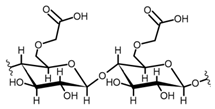 | La (III) | 38.0 101.0 107.0 | 25, 3–4 | [94] |
| Graphene oxide/polyethylene glycol/carboxylated bacterial cellulose IIP | 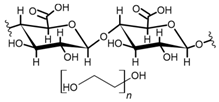 | Dy (III) | 49.9 | 25, 4.0 | [95] |
| Phosphorylated nanocrystalline cellulose (NCC)/carbon nanotubes |  | La (III) | 45.9 | 25, 4.0 | [96] |
| Carboxylated NCC/carbon nanotubes IIP |  | Dy (III) | 34.0 | 25, 4.0 | [97] |
| Cellulose@SiO2 |  | Eu (III) | 24.2 | 25, 6.0 | [98] |
| La (III) | 29.4 | ||||
| Cellulose@Zn/Al layered double hydroxide (LDH) | 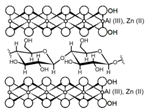 | Y (III) | 102.2 | 25, 7.0 | [99] |
| La (III) | 92.5 | ||||
| Ce (III) | 96.2 |
Publisher’s Note: MDPI stays neutral with regard to jurisdictional claims in published maps and institutional affiliations. |
© 2022 by the authors. Licensee MDPI, Basel, Switzerland. This article is an open access article distributed under the terms and conditions of the Creative Commons Attribution (CC BY) license (https://creativecommons.org/licenses/by/4.0/).
Share and Cite
Salfate, G.; Sánchez, J. Rare Earth Elements Uptake by Synthetic Polymeric and Cellulose-Based Materials: A Review. Polymers 2022, 14, 4786. https://doi.org/10.3390/polym14214786
Salfate G, Sánchez J. Rare Earth Elements Uptake by Synthetic Polymeric and Cellulose-Based Materials: A Review. Polymers. 2022; 14(21):4786. https://doi.org/10.3390/polym14214786
Chicago/Turabian StyleSalfate, Gabriel, and Julio Sánchez. 2022. "Rare Earth Elements Uptake by Synthetic Polymeric and Cellulose-Based Materials: A Review" Polymers 14, no. 21: 4786. https://doi.org/10.3390/polym14214786
APA StyleSalfate, G., & Sánchez, J. (2022). Rare Earth Elements Uptake by Synthetic Polymeric and Cellulose-Based Materials: A Review. Polymers, 14(21), 4786. https://doi.org/10.3390/polym14214786







